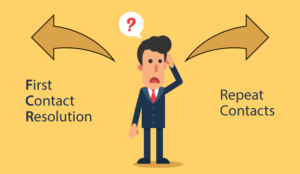Following our 2022 webinar ‘Driving Down Repeat Contact‘, our expert panel share their best advice on reducing repeat contacts.
1. Determine Calls That Are Abnormally Long
We also determine calls that are abnormally long, as they run a higher risk of being complicated or needing further processing to ensure we are providing coaching and feedback to the agent.
We have found that, in most cases, the agent is having to reach other departments for help when they have the resources to find the answer themselves.
Thanks to Macie
2. Train Your Staff to Understand the Customer Viewpoint
We really try to make sure we train our staff to understand the customer viewpoint. We ask them to put themselves into our customers’ shoes – to think about what pain points we can avoid by being better in that first interaction
Thanks to Becci
3. Train Your Team With Call Handling Techniques
We have trained our team with call handling techniques such as “Wallpaper Effect”, i.e. agents ignore previous contacts and don’t make assumptions, “Traffic Light”, i.e. green is a calm customer – red is emotional. It allows each interaction to be judged and handled on its own merit.
We have also introduced a knowledge base with decision trees and easy-to-understand/follow process maps. All this is followed up with regular coaching.
Thanks to Gavin
4. Understand the Customer
We are going to start educating on the intent to understand the customer and not just the intent to reply. So we understand the life event of why the customer called and not just the reason.
Thanks to Rebekah
5. Send a Survey out to Customers
We find that sending a survey out to customers periodically allows us to iron out any issues and we also send out surveys for those who have recently contacted us to try and categorize them into query subject to assess frequency.
Thanks to Katie
6. Implement Tags for Agent Calls
We have implemented tags for our agents calls to determine what our customers call about to promote specific training areas to help educate our agents to have first call resolution.
Thanks to Macie
7. Hold Regular Collaboration Sessions
Hold regular collaboration sessions between agents and leadership teams. Use this time to review previous contacts and share best practices / improvements.
Thanks to Tomas
8. Coach on Communication Techniques
Coach on communication techniques to recognize opportunities for changing comms channels to better understand and deliver great experiences.
Thanks to Sarah
9. Ask the Correct Questions
To be able to understand the customer’s need you need to ask the correct questions. It can be too easy to assume you know why the customer is calling.
Thanks to Trudy
10. Use a Quality Model
Using a quality model (checking the quality of the call/contact) helps to quantify the value irritant matrix data if used alongside any contact logging (using the same data labels) and capturing call times. Over time, this helps to show how this impacts the operation and what benefits a change has made.
Thanks to Martyn
11. Have Scheduled Trend Reviews
Have scheduled trend reviews with the SMEs to help identify the repeat calls and subjects to prioritize, then use a simple project management tool to track all the actions which come out of these in terms of knowledge base actions or wider issues to address in the business.
Thanks to Robert
12. Transfer Certain Callers Directly to a Manager
Instead of offering a callback, have a process in place to transfer certain callers directly to a manager if the agent cannot assist to customer’s satisfaction on first call.
Thanks to Lashell
13. Knowledge Bases Are So Under-Valued
One of my favourite places to start – knowledge bases are so under-valued. They’re especially useful when there’s a single source of the truth across all channels
Thanks to Peter
14. Create a Customer Listening and Quality Assurance Path
Create a customer listening path and quality assurance path to hear both the customer’s and agent’s side of the journey. Plot these along your customer journey map. This will allow you to identify where the friction appears on both sides. Go for these first! This will have the biggest impact first.
Thanks to Becky
15. Set Up a Safe Environment
Set up a safe environment to perform test and learn for your people to make rapid, measurable procedural impacts to understand the change in repeats per experiment.
Thanks to Phil
Here are some more articles on repeat contacts
- 15 Speed Tips for Reducing Repeat Contacts
- Top Tips for Reducing Repeat Calls
- The Difference Between Measuring Repeat Contacts and First Contact Resolution
- Five Tips for Reducing the Strain of Repeat Calls
Author: Rachael Trickey
Published On: 5th Jul 2022 - Last modified: 21st Sep 2022
Read more about - Hints and Tips, First Contact Resolution (FCR), Repeat Calls



































